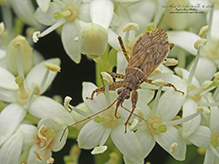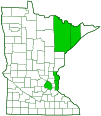short-winged nabis
(Nabis rufusculus)
Conservation • Description • Habitat • Ecology • Distribution • Taxonomy
|
|
||||||||||||||
Description |
Short-winged nabis is a small damsel bug. It occurs in the United States in the east from Maine to Virginia, west to Minnesota and Illinois, and in the west in Washington and Oregon. It occurs across southern Canada from Nova Scotia to British Columbia. Adults are active from April to September. They are found low on vegetation in an array of habitats, including fields and gardens. They feed on soft-bodied insects. Adults are ¼″ to 5⁄16″ (6.0 to 8.0 mm) in length. The body is soft, slender, and oblong egg-shaped. The coloration is light brown, light yellowish brown, or light reddish brown (pale), with dark mottling. There are two forms: the short-winged (brachypterous) form, and the long-winged (macropterous) form. On the short-winged form, the wings reach beyond the middle of the abdomen. On the long-winged form, the wings extend to the tip of the abdomen. The short-winged form is more common. The head is small and slender. At the front of the head there is a rounded lobe (tylus) that projects forward. The neck is very short. There are two large compound eyes and two small simple eyes (ocelli). The compound eyes are bulging. Though smaller than the compound eyes, the ocelli are relatively large. Behind the eyes the head is parallel sided or almost parallel sided. The antennae are exposed, conspicuous, and long, much longer than the head but not quite as long as the body. They have four segments. The first segment (scape) is as long or only slightly longer than the width of the head through the eyes. The fourth segment is longer than the scape. The mouth parts are optimized for piercing and sucking. They take the form of a prominent, 4-segmented beak. The beak is slender and much longer than the head. It extends along the underside of the body between the legs when not used. The underside of the head is mostly yellowish to brick red. The exoskeletal plate covering the thorax (pronotum) has a wide, distinct collar at the end (nearest the head). The small triangular plate between the wing bases (scutellum) may have depressed, semicircular spots on each basal angle, but if present they are poorly developed, not conspicuous. There are two pairs of wings, and they are held flat over the body when at rest. When fully developed, the forewings (hemelytra) on the mature long-winged adult completely cover the sides of the body. They have a thickened section at the base and a thin membranous section at the tip with a clear dividing line between the two. The thickened basal part is comprised of a narrow area (clavus) behind the scutellum when the wings are closed, and the remaining, broad, marginal area (corium). The clavus is widened at the rear. A long submarginal vein in the membranous section separates an inner row of long closed cells and an outer (marginal) row of short open cells. The hindwings are thin, membranous, and concealed under the forewings. Each abdominal section is enlarged laterally creating a continuous, flat, border (connexivum). On the underside of the abdomen, the connexiva are separated from the body by a distinct longitudinal groove. The legs are long and pale. On the front legs, the third segments (femurs) are slightly thickened and are heavily spotted above. The fourth segments (tibiae) are armed with sharp, spine-like teeth. On the middle and hind legs, the femurs are also spotted. The end part of the leg (tarsus), corresponding to the foot, has only 3 segments. |
Size |
Total length: ¼″ to 5⁄16″ (6.0 to 8.0 mm) |
Similar Species |
Habitat |
An array of habitats, including fields and gardens |
Ecology |
Season |
April to September |
Behavior |
Adults are usually found on grass or low on vegetation. |
Life Cycle |
Adults females probably overwinter after mating and deposit eggs in the spring. Nymphs pass through five stages (instars) before emerging as adults. |
Nymph Food |
Soft-bodied insects |
Adult Food |
Soft-bodied insects |
Distribution |
||
|
Sources |
|
| 2/25/2025 | ||
Occurrence |
||
|
||
Taxonomy |
|
Order |
Hemiptera (True bugs, Hoppers, Aphids, and Allies) |
Suborder |
Heteroptera (True Bugs) |
Infraorder |
Cimicomorpha |
Superfamily |
Naboidea |
Family |
|
Subfamily |
Nabinae |
Tribe |
Nabini |
Genus |
Nabis |
Subgenus |
Nabis |
Subordinate Taxa |
|
|
|
Synonyms |
|
|
|
Common Names |
|
short-winged nabis |
|
Glossary
Beak
In plants: A comparatively short and stout, narrow or prolonged tip on a thickened organ, as on some fruits and seeds. In insects: The protruding, tubular mouthpart of a sucking insect.
Connexivum
In Heteroptera: the enlarged, flattened margins of the abdomen. Plural: connexiva.
Corium
The thickened basal portion of the front wing that lies between the clavus and the membrane of insects in the family Hemiptera. Plural: coria.
Femur
On insects and arachnids, the third, largest, most robust segment of the leg, coming immediately before the tibia. On humans, the thigh bone.
Hemelytron
The forewing of true bugs (order Hemiptera), thickened at the base and membranous at the tip. Plural: hemelytra.
Instar
The developmental stage of arthropods between each molt; in insects, the developmental stage of the larvae or nymph.
Ocellus
Simple eye; an eye with a single lens. Plural: ocelli.
Scape
In plants: An erect, leafless stalk growing from the rootstock and supporting a flower or a flower cluster. In insects: The basal segment of the antenna.
Scutellum
The exoskeletal plate covering the rearward (posterior) part of the middle segment of the thorax in some insects. In Coleoptera, Hemiptera, and Homoptera, the dorsal, often triangular plate behind the pronotum and between the bases of the front wings. In Diptera, the exoskeletal plate between the abdomen and the thorax.
Tarsus
On insects, the last two to five subdivisions of the leg, attached to the tibia; the foot. On spiders, the last segment of the leg. Plural: tarsi.
Tibia
The fourth segment of an insect leg, after the femur and before the tarsus (foot). The fifth segment of a spider leg or palp. Plural: tibiae.
Visitor Photos |
||
Share your photo of this insect. |
||
This button not working for you? |
||
Alfredo Colon |
 |
MinnesotaSeasons.com Photos |
||
|
||
|
||

Slideshows |
|

Visitor Videos |
||
Share your video of this insect. |
||
This button not working for you? |
||
|
Other Videos |
||
|

|
Created: 2/25/2025 Last Updated: © MinnesotaSeasons.com. All rights reserved. |


